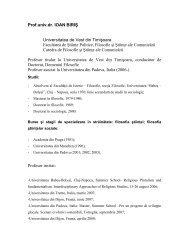analele universităţii de vest din timişoara annales universitatis ...
analele universităţii de vest din timişoara annales universitatis ...
analele universităţii de vest din timişoara annales universitatis ...
Create successful ePaper yourself
Turn your PDF publications into a flip-book with our unique Google optimized e-Paper software.
(METHODO)LOGICAL PRESUPPOSITIONS IN THE WORK OF LEIBNIZ 21<br />
“Because the main thrust in enouncing a proposition is to divi<strong>de</strong> the<br />
relevant set of possible situations – the set of presuppositions – in<br />
two categories or to distinguish those in which the proposition is true<br />
from those in which the proposition is false, using for this purpose a<br />
proposition that does not manage to realize it would obviously<br />
constitute an entirely mistaken approach” (Stalnaker, p. 452).<br />
Consequently, to increase the informational baggage by one statement<br />
means, accor<strong>din</strong>g to Stalnaker, to limit the number of “possible worlds” to<br />
those in which this statement is true. It does not make sense – consi<strong>de</strong>rs<br />
Sandu (1997) as well – for one to enounce a proposition S that logically<br />
presupposes P unless P is true. In the contrary case, the dialogue gets<br />
interrupted and the intention for communication fails.<br />
An immediate observation is that Stalnaker’s pragmatic approach<br />
does not exclu<strong>de</strong> the Fregean logical approach; on the contrary, it<br />
assumes it to be true. Presuppositions’ criterion of i<strong>de</strong>ntification (the<br />
“negation test”, in U. Eco’s words) stops being necessary in a pragmatic<br />
context. Its place is being taken by a pragmatic criterion of a<strong>de</strong>quate<br />
accord between the “new” information and the “old” one.<br />
The problem of projection<br />
One of the problems at the core of the theories on logical<br />
presuppositions, a problem whose solution has been sought by various<br />
scholars such as G. Gazdar, L. Karttunen, R. Van <strong>de</strong>r Sandt, etc., is the<br />
so-called “problem of projection”. The problem poses the question:<br />
What is the relationship between the set of logical presuppositions of<br />
a complex proposition and the set of logical presuppositions of the<br />
elementary propositions that, linked together by various logical<br />
connectors, comprise the complex proposition?<br />
This is not a simple question. The cumulative conjecture proposed by<br />
Langoe<strong>de</strong>n and Savin (1971) offers a solution accor<strong>din</strong>g to which the set<br />
of logical presuppositions of a complex proposition coinci<strong>de</strong>s with the set<br />
of logical presuppositions of each elementary proposition that comprises<br />
the complex proposition. The conjecture assumes that, if logical negation<br />
“conserves” presuppositions, so do all the other logical operators. There<br />
are, and have been highlighted, situations in which the cumulative<br />
conjecture does not work.




